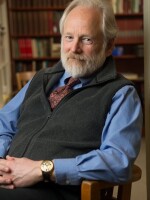For those of us who grew up during the Cold War, when “duck-and-cover” air raid drills occurred in school as often as fire drills, the Berlin Wall was the symbol of what John Kennedy called “a long twilight struggle.” On one side beckoned the Free World; on the other, Communism imprisoned millions. The wall’s solidity reflected the reality of a bi-polar world, a seemingly permanent stalemate. So for most people, the sudden demolition of the Wall and the later collapse of the Soviet Union came as shocks.
Historians debate the causes. Many credit hard-line defense policies of Ronald Reagan, who saw the Soviet Union as a third-world nation with a first-world military establishment and began an arms race to bankrupt it. Others point to internal changes initiated by Mikhail Gorbachev, who believed that the Soviet Union could only be saved by policies of openness, known as Glasnost, and re-structuring or Perestroika. When Soviet satellites began to take advantage of these policies, this argument goes, Gorbachev let them go. Most historians suggest it was a bit of both, adding that the fifty-year-old policy of “containment” worked. If we were patient, Dwight Eisenhower told us, the Soviet empire would collapse from within and he was right.
But some historians of 1989 forget that few people at the time understood those causes or saw what was coming. If anything the Cold War seemed to be getting worse. In the mid ‘80’s tensions between the superpowers were at their highest since the Cuban Missile Crisis, thanks in part to Reagan’s sabre-rattling. Pundits warned that dissident groups in Soviet-occupied Eastern Europe would be crushed, as the Soviets had done in Hungary in ’56 and Czechoslovakia in ’68. Indeed, earlier in ’89 the People’s Republic of China had brutally suppressed a pro-Democracy movement at Tiananmen Square and most policymakers saw a Tiananmen-style crackdown as the next step in eastern and central Europe. Few anticipated the sudden collapse of the wall and eventually of the Soviet Union itself.
Failure to recognize this reflects “hindsight bias” – the tendency to view what actually happened as more probable than alternatives that seemed more likely at the time. What actually happened, in other words, looks as if it had to happen and scholars begin to explain it that way.
But historians must acknowledge that other outcomes were distinctly possible. They must explain not just why something happened, but why something else didn’t. Otherwise they fall into the historical error of assuming inevitability.
So the fall of the Berlin Wall offers lessons in historical practice as well as lessons in history. We’d do well to ponder the deeper meaning of one scholar’s observation: “No one foresaw this, but everyone could explain it afterward.”





